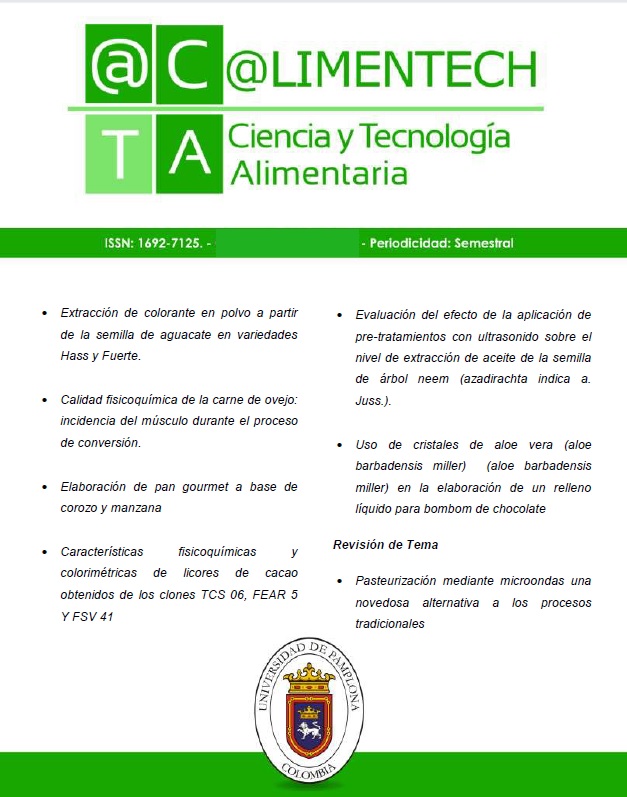Evaluación del efecto de la aplicación de pre-tratamientos con ultrasonido sobre el nivel de extracción de aceite de la semilla de árbol neem(AZADIRACHTA INDICA A. JUSS.)
DOI:
https://doi.org/10.24054/limentech.v17i1.332Palabras clave:
Aceite, Cromatografía, Extracción, Neem, Secado, UltrasonidoResumen
Las extracciones asistidas por ultrasonido, han permitido aumentar la concentración y mejorar las características de diversos compuestos. Para evaluar el efecto del ultrasonido en la extracción de aceite de semillas de neem (Azadirachta indica A. juss.), las semillas se sometieron a un secado convectivo a 70 °C por 8,7 horas. Se aplicó sonicación a 40 kHz con temperaturas de 30 °C, 40 °C y 50 °C y tiempos de 20, 30 y 40 minutos en semillas de Neem (Azadirachta indica) con un 34,12 % de contenido de aceite. Se realizaron extracciones por el método sólido-líquido por lixiviación con solvente n- hexano y los datos obtenidos fueron analizados mediante un diseño estadístico de dos factores con tres niveles cada uno y una variable de respuesta dada por el rendimiento que arrojó 17,6 % en el mejor tratamiento con una desviación estándar a 0,405 un nivel de significancia de 0.05 %. El aceite obtenido fue caracterizado fisicoquímicamente, así como fue realizada la determinación de perfil de ácidos grasos por cromatografía, en la que se pudo establecer que el ultrasonido presenta un efecto significativo en la disminución de los ácidos grasos saturados y un aumento en el porcentaje de ácidos grasos insaturados, mejorando el comportamiento físico-químico del aceite y haciéndolo más apto para la producción de biodiesel.
Descargas
Referencias
Bernal, G. (1991) Descripción general del proceso eficiente de clarificación del aceite de palma y de sus condiciones de operación, Plamas, pp. 112-115.
Campo V. Yesenia y Gélvez O. Víctor M. (2013). Efecto de la termosonicación sobre las propiedades fisicoquímicas del hongo comestible (Pleurotus ostreatus) fresco empacado al vacío. BISTUA: Revista de la Facultad de Ciencias Básicas. ISSN 0120-4211. Volumen 9 N° 2. Pp: 55 – 63.
Castro, P., Coello, J., y Castillo, L., (2007), Opciones para la producción y uso del biodiesel en el Perú, Lima: Soluciones prácticas ITDG.
Falasca, S. L. y Bernabé, M. A., (2010). El árbol del Neem: ¿aceite para Biodiesel o para Bioinsectida?, NextFuel, pp. 1-9.
Hidalgo, M., (2002). Obtención del aceite de semilla de nim Por extracción de gasolina natural Estudio preliminar, Guayaquil: Univerisdad de Guayaquil, 2002.
Kamalu, T., y Uko, O., (2008), Trend of food consumption and efficiency of broiler production with raw or heat-treated neem kernels, Archivos de zootecnia, pp. 489-496.
López Gomar, M. M. Caracterización de la fracción lipídica extractable de la semilla del árbol de Neem (Azadirachtin indica a. juss) obtenida a nivel laboratorio por lixiviación, Guatemala: Universidad de San Carlos de Guatemala, (2012).
Martinez, A (2001). Aceites esenciales, Facultad de química farmaceutica, pp. 1-34.
Oñate, R., y Quintero, L., caracterización fisicoquímica de los extractos de la semilla del árbol de Neem (Azadirachta Indica) En El Departamento Del Cesar, Valledupar: Universidad Popular del Cesar, 2008.
Padoin, D., Assumpc, D., Alucas, B., Eduardo, H. y Guilherme, L. (2016). [3:38:05 p. Convective drying of papaya seeds (Carica papaya L.) and optimization of oil extraction, Industrial Crops and Products , pp. 221-228.
Pérez, A., Vitola, D.; Villarreal, J.; Noya Barreto, M.; Pérez Pérez Y.; Ramírez Sevilla, A.; Rangel Pérez, M. (2017). Actividad antimicrobiana de aceites esenciales de naranja dulce (citrus sinensis) y limón criollo (citrus aurantifolia) como control en el añublo bacterial de la panícula del arroz. Revista @limentech, Ciencia y Tecnología Alimentaría. ISSN:1692-7125. Volumen 15 N°2. Pp. 28 – 44
Pua, R. Amparo L. y Barreto, G. R., Ariza, C. S. (2015). Extracción y caracterización de lapectina obtenida a partir de la cáscara de limón Tahití (citrus x latifolia) en dos estados de maduración. Revista @limentech, Ciencia y Tecnología Alimentaria. ISSN 1692-7125. Volumen 13, N° 2, p.p. 180 – 194.
Púa R., Amparo L., Barreto R., Genisberto E., González A., Jessica., Acosta V., César. (2016). Composición nutricional de las hojas del silbadero (geoffroea spinosa jacq) del municipio de Tubará (atlántico). Revista@limentech, Ciencia y Tecnología Alimentaria. ISSN 1692 7125. Volumen 14, N° 1, p. 38 -48.
Romero, C. y Vargas, M. (2005). Extracción del aceite de la semilla de neem (Azadirachta indica), Revista Ciencia vol 13, pp. 464 –474.
Romero B., Pedro E., y Gélvez Ordóñez Víctor M. (2013). Efecto de los campos magnéticos y el ultrasonido sobre la calidad microbiológica y las propiedades funcionales en una emulsión de carne de bufalo (bubalus bubalis). BISTUA: Revista de la Facultad de Ciencias Básicas. ISSN 0120-4211. Volumen 11 N° 1. Pp: 67 – 76.
Santos, E. (2012). Principales características de las materias primas utilizadas en la producción de biodiesel: la influencia del contenido y la concentración de los ácidos grasos. Ingenium Revista de la Facultad de Ingeniería, pp. 53-61.
Villamizar, R Parra, MLM (2015). Uso de Nanopartículas de plata en el control de microorganismos patógenos presentes en alimentos. Revista @limentech, Ciencia y Tecnología Alimentaria. ISSN 1692-7125. Volumen 13 N° 1. Pp: 54 – 59.
Descargas
Publicado
Número
Sección
Licencia
Derechos de autor 2019 @limentech, Ciencia y Tecnología Alimentaria

Esta obra está bajo una licencia internacional Creative Commons Atribución-NoComercial 4.0.








